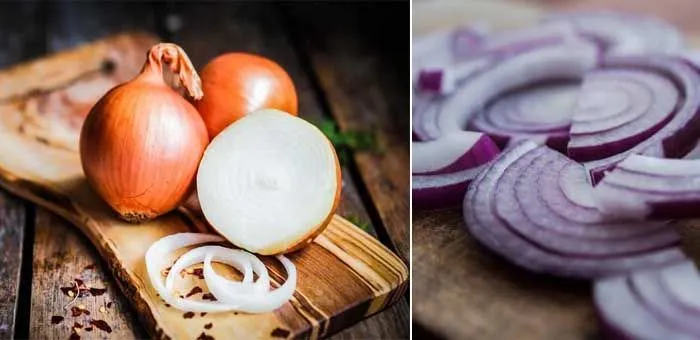In each of the plant foods that we usually consume, an arsenal of mineral compounds, vitamins and phytostimulant substances that produce an impact on the body is stored.
And this impact, in most cases is positive and, depending on the dose, can be harmful.
It does not happen in the case of onions, a food implanted many years ago in the world food. A product that rarely a culture discards because of the incredible gastronomic potential that it offers us.
As for the properties of the onion, we also have a rich arsenal of elements that bring us many benefits. And it is that its powerful flavor is characteristic for the high concentration of elements rich in sulfur and that produce a beneficial impact on our body.
Let’s study the properties of onion and how it can help us on a day-to-day basis.
Table of Contents
The genus Allium and the properties of onion, garlic, leek and scallions
To begin the study of the components present in the properties of the onion, we have to stop to analyze what is special about the genus Allium with respect to the rest of plants in the world of botany.
Although not all plants of this genus have this strong flavor, the most representative (leek, onion, garlic and scallion) do.
This is due to its high content of phytochemicals known as sulphides and allyl sulfoxides. To produce them, the plant needs an initial component or precursor that is known as alliin.
The alliin is a sulfoxide derived from the amino acid cysteine. A water-soluble compound that is formed when we cut garlic or onion and bind the enzyme alliinase with cysteine, forming the compound alliin.
Hence, it is characteristic that allyl sulfoxides are emitted to the medium (specifically thiopropanal sulfoxide) that produce the eye irritation so characteristic when splitting the onion.
Nutritional composition
The onion has a low caloric percentage because most of it is made up of water. 100 grams of onion only provide 23 kcal to the body of which proteins are 1.4 grams, fats are 0.2 grams (0 grams of cholesterol), 3.5 grams of carbohydrates and 1 gram of fiber.
Mineral content
- Calcium: 114 mg (11.4% recommended daily allowance)
- Iron: 1.5 mg (15% recommended daily allowance)
- Sodium: 220 mg (recommended less than 2000 mg)
- Potassium: 392 mg (11.2% recommended daily allowance)
- Phosphorus: 46 mg (6.6% recommended daily allowance)
- Selenium: 0.7 mg (1.0% recommended daily allowance)
Vitamin content
| Compound | Quantity | % recommended daily |
| Vitamin B1 (thiamine) | 0.04 mg | 3,80% |
| Vitamin B2 (riboflavin) | 0.04 mg | 2,50% |
| Vitamin B3 (niacin) | 0.4 mg | 2,30% |
| Vitamin B6 | 0.1 mg | 5,88% |
| Folate | 16 μg | 4,00% |
| Vitamin C | 19 mg | 31,60% |
Phytochemicals present
- Quercetin
- Alliin
- Thioacrolein
- Allyl sulfides
- Vinyldiitiins
Benefits and properties of onion

Boosts the immune system
There are several scientific investigations carried out on the properties of the onion that show its potential for health in various pathologies.
Specifically, the organosulforated compounds Like allicin, propyl propane thiosulfonate exhibit immunomodulatory and immune-enhancing properties.
The compound allicin is used in numerous immunohanizing drugs and the intake of plants rich in this element (genus Allium) is recommended in situations of weakness or as a preventive against immune diseases.
The main problem of the allicin compound is its low stability when handled to make drugs or tablets, so the benefits shouldn exit directly from consumption of vegetables (onion, garlic, leek, etc.).
Prevention of different types of cancer
Although it is logical to think that the abundant consumption of fruits and vegetables reduces the formation of different types of tumors (especially those of the colon and stomach), the behavior of each vegetable and the presence of its phytocompounds has been studied to explain the response it produces in the body.
These investigations highlight the properties of onions for their content of sulfur and other plant extracts to reduce the bioactivation of carcinogens, redox modification and antimicrobial activities. [Study 1]
Another study published in the Journal of National Cancer Institute related the taking of products of the genre Allium and the prevention of prostate cancer. They concluded that men with higher intake of vegetables of this type had a lower risk of prostate cancer. [Study 2]
Impact on anaemia
Although precisely the amount of iron that contains the properties of onion It is not comparable with other foods rich in this micronutrient, there is a relationship with the ability to increase a vitamin compound that has a transcendental impact on iron.
The consumption of 100 grams of onion provides around 16 mg of folic acid. This, added to other foods rich in this compound (leafy vegetables, legumes, nuts, etc.) allows us to reach the recommended 400 mg daily.
Antimicrobial properties
One of the main effects of the properties of onions, especially for their amount in sulfur compounds, is its ability to reduce microbiological development.
Mechanisms to reduce populations of pathogenic microorganisms such as Escherichia coli, Staphylococcus aureus, Pseudomonas aeruginosa and Bacillus cereus, causing a multitude of respiratory and gastrointestinal diseases.
The answer is found in quercetin and allyl sulfides, which are potentially fatal to this type of pathogenic bacteria (including Vibrio cholerae, responsible for cholera in humans).
It also inhibits negative bacteria present in the stomach that cause disorders, such as Helicobacter pylori, damaging the cell walls and their membranes and completely destroying their activity. [Study 3]
Quercetin May Help in Heart Health

A very interesting compound present in the properties of onions is the quercetin.
Many studies have associated this flavonoid with its biological properties and antioxidant activity. Therefore, its consumption can benefit to reduce free radicals, cholesterol and blood pressure, as is also being studied in resveratrol. [Study 4]
As for coronary heart disease, its activity is being investigated in different countries since, in the first instance, the properties of the onion have had a good activity against the formation of triglycerides, for its anti-inflammatory activity and in the formation of blood clots. [Study 5]
On the other hand, more than 25 antioxidant compounds have been identified in the properties of onions, such as anthocyanins, flavonoids, carotenoids and sulfur compounds that reduce the presence of nitrogen-derived free radicals with carcinogenic activity.
May Reduce the Negative Effects of Diabetes
Most plant compounds are being studied today, looking for better alternatives for the control or regulation of diabetes.
This disease protagonist in the twenty-first century increasingly affects more people and greatly harms public health and the health status of the population.
Therefore, look for an alternative through vegetables, such as in the properties of onions, and be able to integrate them into a specific program of Medicines, is the great headache of endocrinologists.
High onion consumption has been associated with a lower glycemic index and a greater response of the body in the control of blood glucose.
Although more research is needed to find more reliable results, several studies have documented a reduction of 40 mg per deciliter of blood in people with type 2 diabetes with the consumption of 100 grams of fresh onion daily. [Study 6]
These same studies are being carried out in parallel on animals to evaluate the behavior of the compounds that are part of the properties of the onion against diabetes.
Activity on bone density
Regular onion consumption has been linked to increased response in bone formation and bone strengthening.
Not because of its calcium or magnesium content but because of its ability to improve the assimilation of these elements when combined with other foods.
These properties of the onion are especially interesting for perimenopausal and postmenopausal women who usually have problems reducing bone mass.
People who took onions at least once a day had 5% more overall bone density than people who ate them once a month or less.
Quercetin extract
Although the conservation of alliin, as we have mentioned, is very complex, the opposite happens with the antioxidant compound quercetin. This extract can be purchased in specialized stores.
Contraindications of onion
The risks in the consumption of onions are very small and are well known.
Basically, the problems derived from the onion are related to allergy to some of its compounds, especially present in all plants of the genus Allium.
In any case, it is easily identifiable and treatable since it is a food widely consumed throughout the world and in all cuisines for many centuries.
Do you know more properties of onion?
